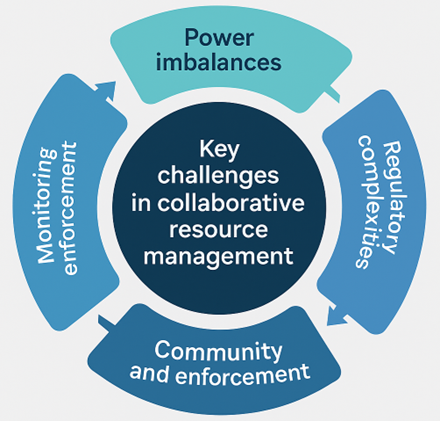The extractive industries, particularly those operating on a large scale, are facing growing pressure to balance resource exploitation with environmental responsibility and social accountability. As concerns over biodiversity loss, water scarcity, and carbon emissions intensify, stakeholders demand more transparent and inclusive approaches to managing natural resources. In this context, collaborative models-bringing together governments, corporations, communities, and environmental organizations-have emerged as a promising solution for achieving long-term sustainability goals.
These models emphasize shared governance, joint decision-making, and equitable distribution of benefits. They aim to reduce conflicts, foster local empowerment, and promote regulatory compliance while maintaining industrial productivity. However, the successful implementation of such frameworks requires overcoming institutional fragmentation, power asymmetries, and divergent stakeholder interests.
The objective of this article is to explore the structure, effectiveness, and practical challenges of collaborative models in the context of sustainable resource management within large-scale extractive operations.
Main part. Principles and typologies of collaborative governance in extractive industries
Collaborative governance in the context of extractive industries refers to the structured interaction between multiple stakeholders-public authorities, private companies, civil society, and indigenous communities-aimed at achieving common environmental, economic, and social goals [1, p. 101144]. This approach stems from the recognition that sustainable resource management cannot be effectively achieved through unilateral decisions or top-down regulation alone. Instead, it requires the active involvement of those directly or indirectly impacted by industrial activity [2, p. 16-20].
There are several typologies of collaborative models relevant to the extractive sector. One common form is the multi-stakeholder platform, which brings together various actors in a forum for negotiation, planning, and conflict resolution. Another is the public-private partnership (PPP), where governmental and industrial actors jointly finance and manage resource projects with agreed sustainability indicators. More community-focused arrangements include benefit-sharing agreements and co-management schemes, particularly in areas with a high presence of indigenous populations or protected ecological zones [3, p. 102343].
Successful collaborative governance models are characterized by transparency, mutual accountability, equitable participation, and long-term institutional support. However, the degree of collaboration varies widely depending on the regulatory environment, political will, corporate culture, and civil society capacity [4, p. 26-31]. In some cases, collaborative efforts remain symbolic, lacking enforceability or leading to the marginalization of weaker voices.
By understanding these typologies and their operational dynamics, it becomes possible to assess the conditions under which collaborative models can contribute meaningfully to sustainable development in large-scale extractive contexts [5, p. 995-1004].
Key challenges in implementing collaborative sustainability models
Implementing collaborative models in large-scale extractive industries is complicated by several structural and institutional factors [6, p. 31-37]. A primary obstacle is the divergence of stakeholder interests: governments focus on revenue, corporations on efficiency, and local communities on social and environmental outcomes. These conflicting priorities often result in weak trust and fragmented governance.
In addition, limited institutional coordination, insufficient data transparency, and unequal decision-making power further constrain effective collaboration [7, p. 40-43; 8, p. 55-62]. Especially in developing regions, regulatory fragmentation and a lack of participatory tools hinder inclusive management practices.
Figure presents the main categories of challenges, grouped into four domains: stakeholder alignment, institutional capacity, data infrastructure, and power balance.

Fig. Key challenges in implementing collaborative models for sustainable resource management
The analysis presented in figure highlights that the main barriers to implementing collaborative models for sustainable resource management fall into four interrelated categories: lack of aligned stakeholder objectives, weak institutional support, limited digital infrastructure, and imbalanced decision-making influence [9, p. 102037]. This underscores the need for integrated coordination mechanisms, digital collaboration platforms, and inclusive stakeholder engagement practices at early planning stages. A comprehensive approach is essential to overcoming these challenges and ensuring the long-term sustainability and effectiveness of resource management strategies.
Conclusion
Collaborative models offer a promising pathway to address the multifaceted challenges of sustainable resource management in large-scale extractive industries. By fostering stakeholder alignment, enhancing transparency, and promoting inclusive governance, these approaches can mitigate environmental degradation, strengthen regulatory compliance, and improve socio-economic outcomes. However, their success depends on the establishment of robust institutional frameworks, equitable power dynamics, and continuous knowledge-sharing across sectors. In this context, the integration of digital tools and participatory mechanisms emerges as a strategic enabler of long-term, resilient collaboration.
.png&w=384&q=75)
.png&w=640&q=75)